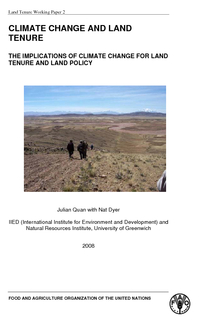Location
The Food and Agriculture Organization of the United Nations leads international efforts to defeat hunger. Serving both developed and developing countries, FAO acts as a neutral forum where all nations meet as equals to negotiate agreements and debate policy. FAO is also a source of knowledge and information. We help developing countries and countries in transition modernize and improve agriculture, forestry and fisheries practices and ensure good nutrition for all. Since our founding in 1945, we have focused special attention on developing rural areas, home to 70 percent of the world's poor and hungry people.
Members:
Resources
Displaying 61 - 65 of 1674ème Recensement national de l’agriculture 2011-2014
La population togolaise est composée de 48,6% d’hommes et de 51,4% de femmes, tandis que la population rurale comprend 48,8% d’hommes et de 51,2% de femmes. De par leur effectif, les femmes jouent un rôle crucial dans le développement du pays en général, et dans le secteur agricole en particulier. C’est pourquoi le prérecensement de l’agriculture réalisé en avril 2012 au Togo a-t-il pris en compte les questions de genre pour mettre en exergue la contribution des hommes et des femmes et de tenir compte de cet aspect dans la constitution de la base de sondage du RNA.
Climate change and land tenure
Land Tenure Working Paper 2. This document analyzes the implications for land tenure and land policy of climate change. It assesses the implications of ongoing anthropogenic climate change resulting from greenhouse gas emissions for land tenure and the role that land policy can play in climate change adaptation planning in the developing world.
IMPROVING TENURE SECURITY FOR THE RURAL POOR
Has 3 main chapters: modes of access to land and natural resources and the tenure situation of the poor and marginalized groups (customary rules, statutory law, development of commercial transactions); some ways of securing land rights for the poor and other vulnerable groups (local resource management agreements, formalization of collective rights and of land transactions, access to justice); can the necessary reforms be carried out?
COLORADO RIVER DELTA
General
The Colorado River Delta is one of the most important sites for migratory waterbirds in Mexico, providing riparian areas, lagoons, brackish marshes, and tidal mudflats that support 350,000 wintering shorebirds (31 species) and 60,000 ducks and geese (26 species). The loss of connectivity between the Delta and the Upper Gulf of California due to sedimentation and low river flow has caused significant habitat loss. This project will protect 26,600 acres of estuarine wetlands in the lower portion of the Colorado River Delta by obtaining a Mexican federal land concession and restore 5,211 acres within this area by augmenting freshwater flows and improving the connectivity with the tides to maintain lagoons, marshes, and mudflats. The project will allocate more freshwater flow to these wetlands and dredge channels that connect lagoons to the primary tidal channel.....
COLORADO RIVER DELTA
General
The Colorado River Delta is one of the most important sites for migratory waterbirds in Mexico, providing riparian areas, lagoons, brackish marshes, and tidal mudflats that support 350,000 wintering shorebirds (31 species) and 60,000 ducks and geese (26 species). The loss of connectivity between the Delta and the Upper Gulf of California due to sedimentation and low river flow has caused significant habitat loss. This project will protect 26,600 acres of estuarine wetlands in the lower portion of the Colorado River Delta by obtaining a Mexican federal land concession and restore 5,211 acres within this area by augmenting freshwater flows and improving the connectivity with the tides to maintain lagoons, marshes, and mudflats. The project will allocate more freshwater flow to these wetlands and dredge channels that connect lagoons to the primary tidal channel.




